|
 |
28-05-2011 A TRIP TO CANNA |
Trip to the Island of Canna, The Bard and the Birlinn
Canna House and Gardens playing host to a day of talks, walks, storytelling and songs celebrating the life and work of Alasdair MacMhaighstir Alasdair, the Gaelic Bard.
Saturday 28th May
An early morning start to the day in Mallaig to catch the 7.20am ferry to Canna. The wind was quite blustery making the sea fairly rough, but never the less as the ferry was fit to sail and we had to prepare ourselves for the two hour or so journey to the Island.
Setting off from Mallaig, the Cal Mac ferry headed into the oncoming waves and the open sea, to say the boat was rocking was an understatement it was like being on a roller coaster as the boat was being hurled about like a top, but experiencing the power of nature our thoughts went to the fishermen who do this on a daily basis for a living in swells probably far bigger in size.
As our boat ploughed through the freezing North Atlantic waves of the Cuillin Sound towards the Island of Rum our first port of call we were able to see the harbour of Mallaig and the coast line of Morar fade in the distance which in turn brought a closer view of the Island of Eigg to our left. This brought back instant memories of a friend Niall Robertson who died tragically near this spot two weeks previous, the consequence of a kayaking incident.
Approaching the Island of Rum the waves calmed, this was to the delight of one of our party who had up until now only seen the inside of a toilet cubicle. With the slowing of the ship and the calming of the waves it gave us a chance to balance ourselves steadily on board, more so on the top outer deck of the boat where we could get a better view, although the power of the wind still made us hold onto the hand rails. Rum is the biggest of the Small Isles and is impressive with its rugged terrain and coast line of high cliffs. Beneath the mountainous back drop is a scattered community with the impressive Kinloch Castle onto which the spring sun shone down on. Before leaving Rum a few people disembarked along with a large van which dropped off supplies, a service undoubtedly a lifeline for the community, but this came back on board.
It’s not far from Rum to Canna, they are only separated by an expanse of water called the Sound of Canna, but a washed up fishing boat on the shore of Rum gave a stark reminder of the danger the sea or ocean presents to even the most experienced sailor.
As we reached Canna or Eilean Chanaigh the most westerly of the Small Isles, the locals lined the harbour to welcome us, as well of course as waiting for their much awaited delivery of mail and groceries etc having been ordered days before and delivered by the same van as previously mentioned. The van was the only vehicle on the ferry although it was quite capable of carrying a few more, this is because vehicles are discouraged from being brought to the Islands as there is very little public road ways to drive on. The locals do have vehicles mainly 4X4’s due to the terrain and are used for work purposes as opposed to leisure.
The hydraulic ramp went down on the ferry to the harbour slip way and after embarking we were greeted by National Trust staff, to whom the Island belongs. We were informed that we had to make our way to the Gille Brighde Cafe and Restaurant a small walk away, it was!!!, taking into account the island is only 7 kilometres (4.3 mi) long and 1.5 kilometres (0.9 mi) wide. Anyhow it was not hard to find as this is the only restaurant on the Island, might I add and a cosy little place it was too, where we were greeted with a refreshments of tea or coffee. Luckily enough as we started walking the weather changed to be on our side at this point as it had up until then been temperamental with light showers with wind, but we were now basking in sunshine with a wee bit of heat in the rays.
For those of you have never visited the Isle of Canna [Eilean Chanaigh] here is a wee insight. There are some 20 buildings between both Canna and Sanday, including three churches, one of which has been deconsecrated. There is also a post office which was converted from a garden shed. The Canna tea room, which closed in 2008, reopened in 2010 as the Gille Brighde Cafe and Restaurant as mentioned above. A new resident manager Stewart Connor was also appointed for the Island in the same year who has already made great changes and plans more for the future, which include the opening of Canna House to the public. The island is isolated and the inhabitants must buy their provisions from the mainland, but it has a telephone link, a red telephone box and broadband internet access, although there is no mobile phone coverage. Electricity is provided by a diesel generator, at mainland voltage and frequency, and there is a private water supply. The island has a very low crime rate, but a mainland-based policeman visits the island twice a year, mainly to inspect gun licences. A doctor based on the neighbouring island of Eigg is available for house calls once a month. The roads on Canna are not as you would find on the main land and are privately owned, local vehicles therefore do not require road tax. The previous footbridge to Sanday was destroyed by storms during 2005, and has recently been replaced by a road bridge. This allows vehicular access at all tide levels for the first time, although the road on Sanday is still covered by high tides. Residents depend on the Mallaig to Canna Cal Mac ferry link for supplies which is approximately a 2½ hour trip, although vehicles do leave the Island residents try to limit their ferry travel due to cost.
Although the island today survives with such a small community there are means of accommodation as well as a wealth of history, culture and heritage and would encourage anyone to make the trip.
This event publicised by the NTS attracted a large amount of people so much so that we had to be split into two groups so places like the church and the restaurant could accommodate us. From the restaurant our group headed along the sea front to the Church of Saint Columba, a small, recently modernised church overlooking the bay, its name continuing to be used from an earlier church now in ruins which once stood at Keill or A'Chill dedicated to St Columba. It was here we were given an introduction by Professor William Gillies and a talk by Meg Bateman. The talk as part of ‘The Bard and the Birlinn’ went quite into depth about one of the poems written by Alasdair MacDonald or Alasdair MacMhaighstir Alasdair as he was better known in Gaelic, with Meg sharing her own views on the meaning of poem with the rest of us.
Alasdair MacMhaighstir Alasdair was a descendant of the chiefs of Clanranald and the Lords of the Isles. The famous Flora MacDonald was his first cousin. Alasdair grew up in Dailea on Loch Shiel in the Clanranald heartland of Moidart. He was raised and taught the ancient corralitir script of the Clanranald bards and studied in Edinburgh and Glasgow at a time when Scottish songs were gaining huge popularity.
Alasdair played a major part in the Jacobite Uprising in 1745 and on returning to Canna afterwards he hoped he would ensure the Gaels cultural survival as it was now at a time when Gaelic traditions and language were under threat more so because of the newly appointed ‘Proscription Act in 1747’. He became renowned for his poetry and is even considered to be one of the finest poets of the 18th century.
Canna had first hand experience of the Hanoverian forces during the uprising when a Royal Navy vessel arrived at Canna on 3 April 1746. The crew demanded 20 cows, which were duly provided by the islanders. However, the ship was bewinded for four days and the sailors complained of the smell of the cattle they had slaughtered and demanded 20 more. The "Bailie" of the island complained that this was unjust. Upon which the officer commanded that all the cattle of the island be gathered and shot, which resulted in 60 of the best being killed, they threw the old beef overboard and would not allow the poor distressed owners to finger a piece of it, no, not a single bit.
On the 18th April "King George's men" went "hunting the Canna women" who had to hide from them in isolated caves and under cliffs. One pregnant woman died after being chased by 12 of them.
Leaving the church behind we were taken on a guided tour by NTS ranger Winnie MacKinnon a native of the island, we crossed over a field to a wooded area where we found the grave of John Lorne Campbell. JLC was the proprietor of the Island who researched the work of Alasdair MacDonald while he resided on Canna, he betrothed the Island to the National Trust for safe keeping in 1981 before his death in 1996. He was buried on the Island at this spot which was dearest to him, because he was amongst the trees that he planted himself.
From the grave we were then shown an early Celtic cross from approximately the 8th or 9th century, but unfortunately being often exposed to harsh elements have taken their toll on the now faded cross, parts of which have been recovered and now reside in Canna House. The lands of Canna once belonged to Iona but were transferred into private ownership during the Reformation to Macdonald of Clanranald who then sold the island after the failure of the kelp boom to Donald MacNeil in 1827.
A stones throw away from the cross was the location where 400 residents lived once upon a time before all being cleared in 1851 when it was then under the ownership of Donald MacNeil's son Donald, who was a minor at the time. The post-clearance population 30 years later is recorded as 57 in 1881 (with a further 62 on Sanday), the same year in which MacNeil sold the island to Robert Thom, a ship owner from Glasgow. His more enlightened stewardship continued until 1938 when his family sought a sympathetic purchaser and sold to John Lorne Campbell, but really from the time of 1881 the population of Canna has been in decline. To think that there used to be so many inhabitants on Canna when today there is only between 10 and 16 people with people coming and going all the time. It does make you wonder what kind of place the highlands and islands would have been today had the clearances not been so ruthless as they were all those years ago.
From here we were shown the old church which once stood at Keill or A'Chill with head stones centuries old dedicated to St Columba as earlier mentioned. The old church is mentioned numerous times throughout history and even recorded as being in a ruinous condition by Thomas Pennant in 1772 when he made his tour of the Hebrides. It is also believed that it may even mark the location of an early Christian Monastery. From the church we followed a path across a grassy field which took us on a downward slope towards the harbour area where we were shown the old dairy which held a wee exhibition of local history and a view across the bay of Eilean a Bhaird [ the small Island rising above the tidal flats of Canna]
Completing the fantastic wee tour we were back again to the restaurant for a ‘Taste of Canna’ buffet lunch, although a bit crowded a splendid spread was enjoyed by all.
After lunch we were given yet another tour, this time of Canna House guided by Stewart Connor and Julie McCabe and curated by Hugh Cheape and NTS archivist Magda Sagarzazu. Canna House stands proud in centre of what you would call the main street of Canna and although open it is only partially and lucky enough to be even this had it not been for the efforts of the new manager Stewart Connor. The house is famed for housing an extensive library of Gaelic literature and hopefully we will see the house restored to its former glory sometime in the future for the public to enjoy. Although John Lorne Campbell handed the Island over to the National Trust in 1981 he still resided in the house until his passing in 1996, His widow however, the American musician Margaret Fay Shaw, remained at Canna House until her death in 2004 at the age of 101. To correspond with the day a Jacobite Standard flew from the pole in respect of Alasdair MacDonald [ Alasdair MacMhaighstir Alasdair].
After our wee tour of the house and exhibition we returned to the Church of Saint Columba for another talk as part of the Bard and the Birlinn by Gavin Parsons which included Viking longboats and other ship building, it may seem strange to those reading this that Vikings should be included as part of this talk, but in fact the Island of Canna was inhabited by Vikings in its history, this is evident by some of the names around the island.
The penultimate end to the event was a fabulous recital of Gaelic music and song by Gregor Lowrie, for some unexplained reason, somehow being in the surroundings of a small crowded chapel and being on the Island of Canna listening to the sound of gaelic singing, made it more atmospheric.
Unfortunately all good things had to come to an end and after the closing of the conference by Professor William Gillies which was now approaching 6pm we had to make our way to the harbour, say our farewells and catch the return ferry back to Mallaig.
This was a fantastic trip which seemed to be enjoyed by all and well organised by the staff of the NTS.
Many thanks on behalf of Crann Tara to Stewart Connor, Julie McCabe and Winnie MacKinnon and the other members of the National Trust staff who made the trip most enjoyable and educational and additionally for their highland hospitality during our time on Canna.
James Singer
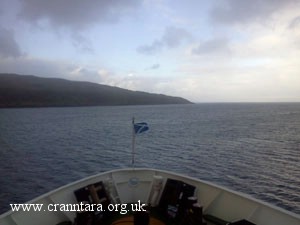 |
 |
Ferry between Mallaig and Canna with the Saltire at the front showing the strength of the wind |
Canna House |
 |
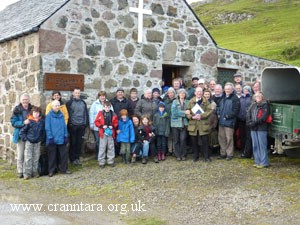 |
NTS Staff in the Chapel of Saint Columba |
A group gathering outside the Chapel |
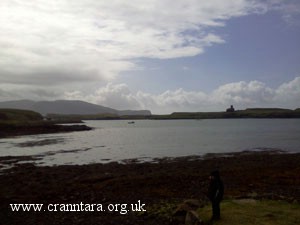 |
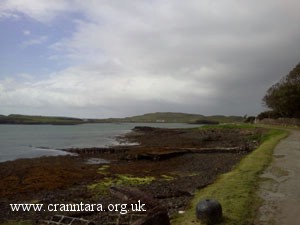 |
A view from the shore of Canna over looking the disused R.C Church on Sanday with Rum in the distance |
A view along the shore of Canna with Sanday in the background |
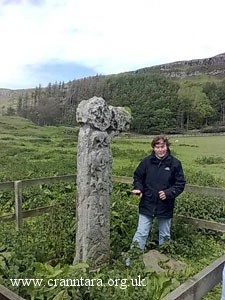 |
 |
NTS Ranger Winnie MacKinnon talks about the Celtic Cross |
A closer look at the stones worn engravings |
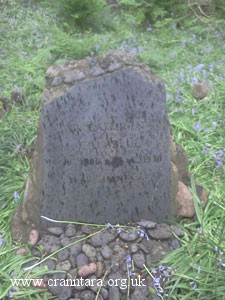 |
The headstone and grave of John Lorne Campbell |
|